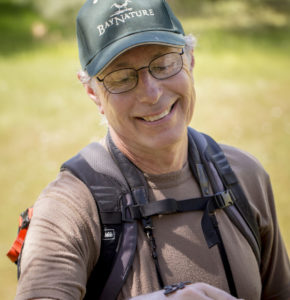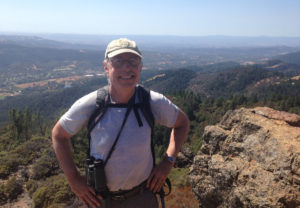My first BayView letter, published in January 2001 in the premier issue of Bay Nature, describes my observations of life in the coast live oak outside my home office window during the extended four-year gestation period of the magazine. I was particularly taken with the pair of bushtits who built a nest (an elaborate but precarious-looking hanging contraption of twigs and other urban oak woodland detritus) in the tree and raised a small family there for two consecutive springs.
Once the magazine was ready to launch, the three-person staff moved into a small office over Picante restaurant in West Berkeley—still the world headquarters of Bay Nature, even though the staff has grown to nine—and I lost my oak view. In fact, I lost any and all views, other than that of a wall covered with some of my favorite images from early issues of the magazine (a western bluebird; bright orange lichen on a boulder; summer evening light on Mount Diablo; a large map of San Francisco Bay tidal wetlands past and present). And even if I had sat at one of the three desks near a window, my view would have been of the cement plant next door, not of an oak woodland.
So I probably won’t miss that aspect of working at Bay Nature when I leave my post as publisher and executive director on June 30, just as this 67th issue of Bay Nature is published. And that, in a nutshell, is one of the reasons that, after 17 years, I’m leaving this dream job. Not because of the office, per se, but because I’m ready to get back out into the world and do more observing of nature myself instead of managing a forum to record the observations of others.
Don’t get me wrong. Just because I haven’t been out in the field doesn’t mean I haven’t been learning and having a great time. This has been one long privileged learning experience, both about running a small nonprofit media organization and about the natural world of my home region. And about the people and organizations whose work is responsible for the incredible diversity of wildlife, protected watersheds, and natural landscapes in the Bay Area. I’ve learned about the reproductive strategies of barnacles and lichens. I’ve learned about the geologic processes that created the red rocks of the Marin Headlands. About the communal habits of acorn woodpeckers. And the resilience of river otters. And just as important, I’ve learned about the truly astounding number and variety of nonprofit organizations and civic initiatives and public agencies, large and small, that have arisen to restore this creek; build that trail; save the Bay; make a park accessible; remove invasive plants; study a tidepool; and so on.
Yes, we’re remarkably blessed in this region to have such a stirring combination of natural beauty, moderate climate, social diversity, and human creativity. But the very same factors that make this such a desirable place to live and that lured me here from New York City in 1973 keep attracting more and more people. When I arrived, the population of the nine-county Bay Area was about five million. Now it’s 7.65 million, a 60 percent increase in 45 years, and a 14 percent increase since Bay Nature was founded in 2000. You can see the impact on our overcrowded roads and bridges and, more seriously, in the insane housing prices that make it difficult for nonprofit workers and young biologists and environmental educators (and many others) to stay in the area and pursue socially valuable careers. And, as we discuss in this issue, the increasing numbers of visitors mean that some of our more popular parks are in danger of being “loved to death.” And, finally, looming over everything, is climate change, with its rising sea levels that will inundate low-lying areas around the Bay, wildland fires that will take an increasing toll on landscapes and human communities alike, and the paradoxical twin threats of prolonged drought and extreme flooding.
So as a region, we have our hands full. Which means there is even more need now than in 2001 for a publication that tells the stories of our natural landscapes, and of the people who care for them, and of the challenges we face, and of the creative solutions to those challenges. I’ve enjoyed having the opportunity to help tell these stories for the past 17 years and having the opportunity to share my thoughts with you in these quarterly letters. This I will miss more than I can say. But these compelling and inspiring stories will keep on coming to you from the next generation here at Bay Nature, because changing times call for fresh perspectives and new voices. So I leave you in good hands as the journey of exploration of the natural world and the Bay Area’s diverse landscapes continues.
As for me, I’m looking forward to having more time for observations in the natural world: in my actual backyard, in my larger Bay Area “backyard,” and farther afield. And in another sign of change, perhaps I’ll record those observations on my iPhone with iNaturalist or submit an occasional post-from-the-field to Baynature.org. (Maybe old publishers can learn new tricks?) See you all out on the trail and out in the field! And thanks for taking this journey with me. I couldn’t—and wouldn’t—have done it without you.
Celebrate David Loeb’s legacy at Bay Nature on Sunday, October 1 at the Oakland Museum of California, with presentations from Greg Sarris, Ellie Cohen, and Claire Peaslee. Check the event page for tickets and more information.




-300x225.jpg)
